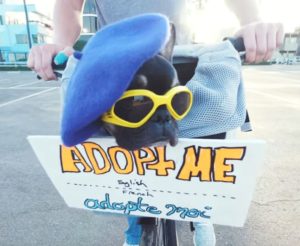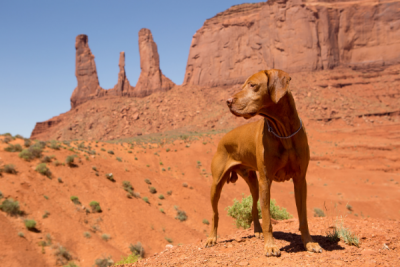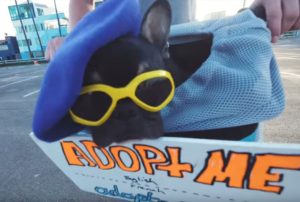Videos French Bulldog Health & Wellness
This Frenchie Died Of A Rare Disease. If You Live In A Hot, Dry Area Beware!
Related Articles
Wade’s Story
Life for Wade began normally enough. This pup thought he had a forever home, but that wasn’t the case. Early in his life, Wade became sick. Instead of helping him, his family abandoned him at a shelter, where he was diagnosed with valley fever. His treatments would be expensive, and Wade’s life was ultimately saved by a loving volunteer, Bernadette from Marley’s Mutts. She took up the daunting challenge of keeping this little pooch healthy.

The treatment Wade needed left him with three useful legs and an easily irritated eye. These challenges made it harder for Wade to be adopted, and he sadly passed away without finding a loving forever home. He did, however, enjoy a wonderful and lovely life with the amazing volunteers at Marley’s Mutts.
While Wade has crossed the rainbow bridge, the lessons he taught us haven’t been lost! We’re sharing his story to help raise awareness of valley fever, a serious condition that all dog owners should be aware of.

What is Valley Fever in Dogs?
To keep Wade’s legacy alive, we want everyone to learn about the rare condition that caused his former family to abandon him. This condition is non-contagious and will not spread to humans, but its symptoms can be absolutely devastating.
How Does Valley Fever in Dogs Spread?

Thanks to the experts at VCA Animal Hospital, we know that this awful disease is caused by a microscopic fungus, Coccidioides immitis. This fungus is naturally found in many dry climates, which is why the disease is also known as California disease, desert rheumatism, and San Joaquin valley fever.
The fungus is mostly isolated to deserts. Arizona, California, Nevada, New Mexico, Texas, and Utah are some of the top spots for this fungus. It may also be found in some parts of Mexico, and isolated samples have been pulled from Washington state.
What are the Symptoms of Valley Fever in Dogs?

When a pup comes in contact with the fungus, the spores attack their lungs. This may happen as little as three weeks or as much as a year after exposure. The first signs of something being amiss will be coughing, wheezing, decreased appetite, and unusual laziness.
Fortunately, this is where the disease stops for many pups. Many dogs will recover from their brush with the fungus, and they will recover well! However, dogs with weakened immune symptoms may have a more serious version of the disease. Vets call this “disseminated” valley fever in dogs.

In this second version of the virus, the fungus spreads to other parts of the pup’s body. As with Wade’s case, the infection will attack the dog’s joints, eyes, and other organs. This often results in sore joints, and severe cases may even lead to blindness!
How is Valley Fever in Dogs Treated?
The treatment for valley fever in dogs is a relatively extensive antifungal prescription. As noted by Doctors of Veterinary Medicine Krista Williams and Cheryl Yuill, the disease often requires a 6–12 month antifungal routine. If the valley fever has invaded other parts of the pup’s body, as was the case with Wade, they may need to take antifungal medications for the rest of their lives.
Fortunately, when the disease is caught early, it’s easily treated. Dogs will often return to their usual selves within 1–2 weeks of treatment, but continuing the routine is essential!
What is the Prognosis for Valley Fever in Dogs?
The good news is that most pups will survive their brush with valley fever. So long as the ailment is promptly treated and stopped in its primary phase, the majority of dogs will survive with no ill effects. Unfortunately, most pups with untreated disseminated valley fever will pass away like Wade.
How Can Valley Fever in Dogs be Prevented?

While there’s no way to guarantee that your pup will not get valley fever, there are many ways to reduce the likelihood of the disease. Because the responsible fungus is a natural part of local soils, there is no way to reliably get rid of it. You can, however, reduce your pup’s exposure to the affected dirt.
Keep Pups Clean

One of the first lines of defense against valley fever is a good bath! Our canine companions may not always enjoy their bathtime, but these pampering sessions do far more than soften their coat and brighten their colors. For dogs in valley-fever-prone areas, keeping their fur and paws free of excessive dust and dirt reduces their exposure to the fungus.
Discourage Digging
As much as dogs love to dig, it’s not very healthy for them to do so in areas that contain the valley fever fungus. Try to keep their outdoor play space free of large, dusty patches and discourage your dogs from digging into the ground. This may be done by rerouting their behavior to a more desirable activity, or you can train them to follow commands such as “leave it”.
Think Green

If you have a dusty backyard, consider planting desert plants, and putting in stones to reduce the amount of dust.
The Tucson College of Medicine notes that one of the best ways to reduce your dog’s exposure to the fungus is to reduce the amount of dusty dirt in your yard. Planting grass and native plants helps the environment and prevents your pup from coming into contact with the fungus. If this isn’t possible, creating a deep layer of gravel or mulch works just as well!
Avoid High-Risk Areas

Your yard isn’t the only place where your pup comes into contact with desert dust. Along the western coast of the United States, pups are exposed to the valley fever fungus in many other places. On daily walks, be mindful of spots where there is an abundance of natural dust. According to Vanessa Farner, DVM, construction sites are an often forgotten source of atmospheric dust. If one of these happens to be on your usual walking route, consider taking a different path with your pooch.
Keep an Eye on Research
Fortunately for pet owners everywhere, scientists are working on a vaccine for valley fever. As of 2022, it is not currently available to the public. However, many vets are hopeful that a publicly available valley fever vaccine will soon be available!
Spread the Word!
Help us remember Wade’s legacy by spreading the word about valley fever in dogs! If you know someone who lives in a valley-fever-prone area of the country, consider telling them about the disease. The best treatment for valley fever is prevention, and with your help, we can prevent other pets from suffering from this terrible illness!
FAQ
1. What season is valley fever most common
Late Summer and Fall
2. Can a dog recover from valley fever?
Yes. most pups will survive their brush with valley fever. So long as the ailment is promptly treated and stopped in its primary phase, the majority of dogs will survive with no ill effects.
3. What are the early signs of valley fever in dogs?
The first signs will be coughing, wheezing, decreased appetite, and unusual laziness.
4. Is valley fever in dogs contagious?
No
5. What is the treatment for valley fever in dogs?
The treatment for valley fever in dogs is a relatively extensive antifungal prescription. As noted by Doctors of Veterinary Medicine Krista Williams and Cheryl Yuill, the disease often requires a 6–12 month antifungal routine. If the valley fever has invaded other parts of the pup’s body, as was the case with Wade, they may need to take antifungal medications for the rest of their lives.
6. What are the symptoms of valley fever
Coughing, wheezing, decreased appetite, and unusual laziness. If the dog has a weakened immune system then the fungus spreads to other parts of the pup’s body like the dog’s joints, eyes, and other organs. This often results in sore joints, and severe cases may even lead to blindness!
7. How to prevent valley fever in dogs
a. Frequent bathing
b. Don’t allow your dog to dig in a dusty yard
c. Don’t walk in dusty areas
d. If your dog is dusty consider putting in stone, artificial grass and drought tolerant plants
e. If something is wrong with your pup get early treatment
8. Where is Valley Fever most common
Hot desert areas like Arizona, California, New Mexico and Nevada
====
Video Transcript
– [Rocky] One dog, one day, and one mission. I’m Rocky Kanaka and this is Dog’s Day Out. You might be wondering why Wade, this sunglass-wearing Frenchie with a French beret and an adopt-me sign that reads in English and in French, is riding in a basket in my bike, you wouldn’t be the only one. But that’s exactly the reason I’m doing this, to raise awareness because Wade needs a home. You see, his former family abandoned him once he became sick. Wade has valley fever. It’s a disease that can be deadly if left untreated. It’s common in desert areas and while not contagious, it’s often easy to contract valley fever in dogs by breathing in the fungus spores from the dirt and in Wade’s case, most of this could have been prevented if it was treated early on. And what’s really sad, is instead he was just dropped off at this shelter, and with overcrowding, Wade’s serious condition, and the high cost of treatment, it meant that there was little chance that Wade would make it. That’s until Bernadette, a volunteer with Marley’s Mutts Rescue organization stepped in.
– [Bernadette] This new little guy was just pulled out of Shafter Shelter. He has valley fever in dogs, gonna be a lot of a medical costs involved to get him well, so share, donate, let’s get this little guy better. Marley’s Mutts said they’d do whatever it takes to make sure Wade gets a fighting chance, and that’s where I come in because I think this guy’s been through a lot and he deserves some special treatment. His very own dog’s day out. Now the beret, while it’s really cute, is actually serving a dual purpose. He’s so cute and so irresistible and when you meet him you just wanna pet him on the head, but his head is sore to the touch from valley fever and the sunglasses is helping so that the wind doesn’t dry out one of his eyeballs that’s kind of wonky. And this bike ride’s been the perfect start for Wade having a lot of fun but it’s not just about fun today, it’s also about spreading awareness so that we can get Wade into his forever home, so I’m gonna hit the local watering hole and start talking to people so we can get the word out. So if you know anybody that would wanna adopt a Frenchie. It’s a fungus from the desert that gets into their lungs. People or dogs could get it.
– Wow.
– Hi, what’s his name?
– His name is Wade.
– Take a photo of him?
– Yeah, please!
– And he’s with Marley’s Mutts.
– Cute on sale.
– Are you seriously asking for this guy to be adopted right now?
– Yeah, yeah.
– Um.
– No, not today.
– I know, I’m never gonna–
– No.
– He loves you, he’s in love with you, look at that.
– Oh, baby.
– Your husband ran off. He’s gonna be on medication for awhile, but then he’ll be fine.
– I’m a French teacher, and so–
– Oh, did I spell, did I do this right?
– You did!
– Yes?
– You did, look.
– How do you say it, how do you say it?
– So he’ll have a lift that he’ll be able to walk, he’ll be able to–
– Yeah, so I’ll put, I’ll show you. Yeah, someone dumped him in the shelter, and. So we built this giant ball pit for him he’s gonna go play in and he’s gonna get a puppachino.
– Oh, one eye.
– Okay, I think so far we’re off to a good start. But now, we gotta get moving and we’ve got a lot to pack in today for Wade’s Dog’s Day Out. It’s gonna be amazing, I mean, his best day ever. Wait until you see some of the things I have planned. And if you’re new here, welcome, make sure you hit that subscribe button, and if you think this little dude is as cute as I do, then hit that thumbs up button. Make sure you come with me because we’re gonna need your help in giving him the best day ever, and then also helping him find a home. Alright, we’re loaded up in the car. We’re going from Los Angeles to Marley’s Mutt’s Rescue Ranch in Tehachapi. Now there are a few things that I learned about Wade when he stayed with me over the last week. One, he loves his friends. Him and Flip, man, they hit it off right away. Two, he loves food, that’s why that’s why we’re getting puppuccinos. Three, he loves toys, I mean he loves toys. On the very first day, he gathered all the toys around the yard and put ’em in one spot and then dragged me over there to show me. I was blown away because the valley fever in dogs causes him to sleep about 20 hours a day but when he is up, he is ready to play and at first I was taking it easy on his arm but it turns out while he can’t really use it, it doesn’t seem to be bothering him and as you can see, with how much he loves playing fetch. So that led to my next big idea that we’re getting set up right now. I mean, it is big, record-setting, and by far the biggest thing I’ve ever done on Dog’s Day Out. Yeah perfect, check that out. I lined it up so it’s a little more narrow so the dogs can get a good run and then just dive into that ball bit. Set-up is almost done. Now for the best part, we just gotta put all the balls in there. Okay, the ball pit is set up, that is 15,000 balls and this is literally Wade’s dream coming true. Okay my man, you ready for this? You ready? Okay! Oh, somebody’s excited! Are you ready, are you ready? Are you ready, go get it! Go get it! Flip, come on, Flip!
– [Woman] Come on, go get in!
– Everybody come on, come on, come on! You could do it in the ball pit.
– [Woman] Working with dogs.
– Okay, so iHeartDogs heard about this and they sent me a ton of balls that we could put treats in. That way we can go next level and just launch these treat balls into the ball pit. Wade, you can tell, is already excited about this. Okay, Wade, here we go! I’m gonna get the rest of the Rescue Ranch dogs out here and give them a chance to jump in the ball pit too. Ready for sure! Come on, Cora Rose!
– Come on, let’s go in!
– [Rocky] Woo! Well, I tell ya the ball pit was a success and so was the rest of Wade’s Dog’s Day Out. We had burgers and fries, he checked out some really awesome fire hydrants, met some ducks, and he was pretty exhausted, so ended the day with a sunset. You know someone gave up on Wade but we can all come together as a community to show him that that will never happen again. Leave a comment down below for Wade and I will make sure every single one of those are read to him and share this with everyone that you can because the more people that see this, the better chance he has of finding his forever home. Wade has a long and an expensive road to recovery but there are a couple ways you can help. One, you can donate. Two, you can get some Dog’s Day Out merch where funds will go to help Wade. To do that, get more information on Wade, or fil out an adoption application, visit RockyKanaka.com/Wade or click on the link in the description below.



